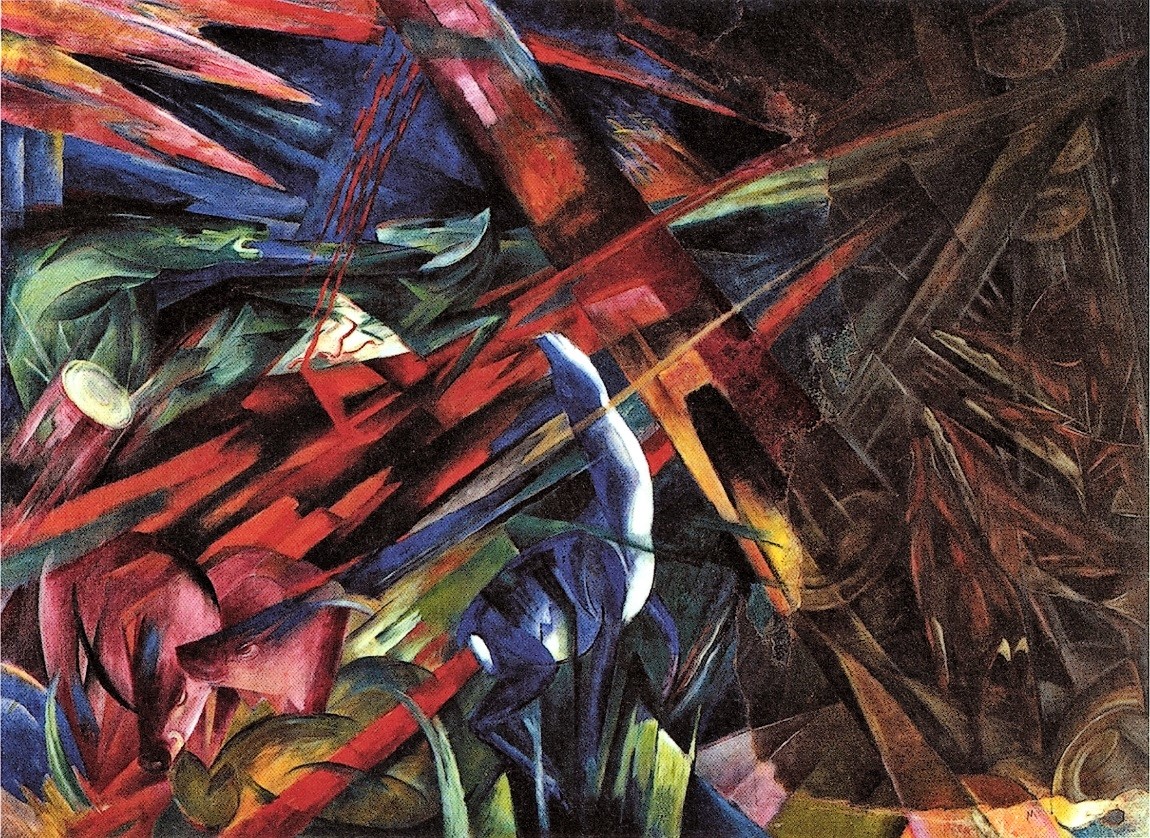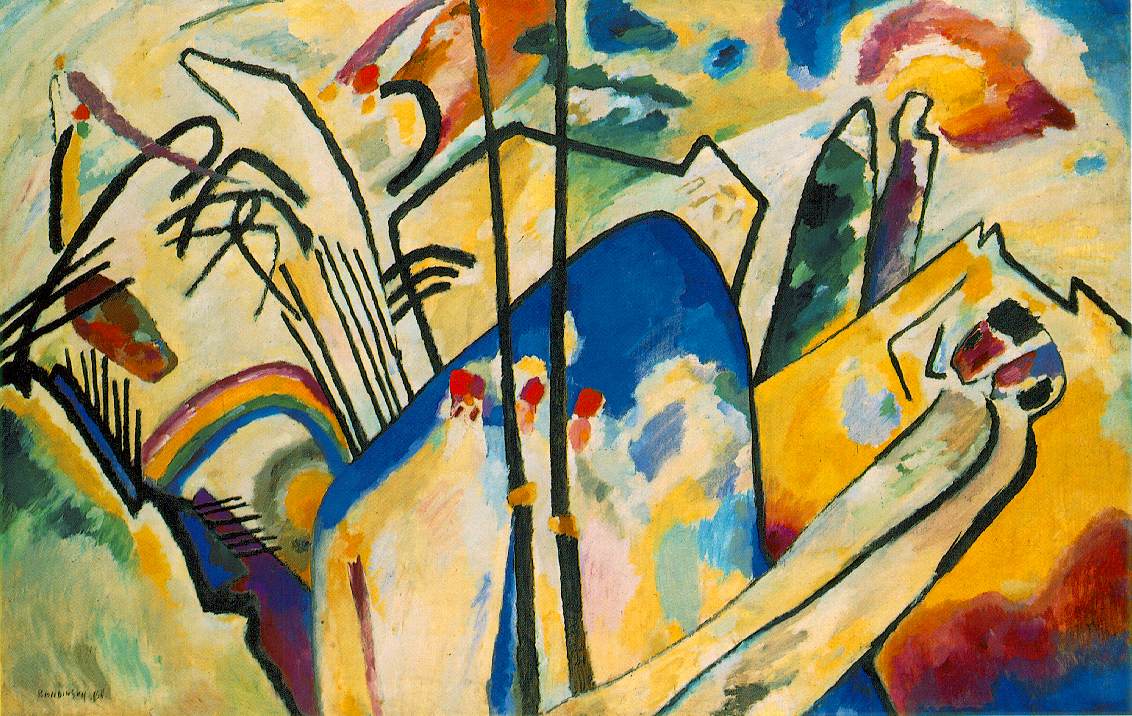Franz Marc has become one of the most populist artists of all the German Expressionist. Marc was born in February 1880 in Munich. His father, Wilhelm Marc, was a professional landscape painter while his mother was a strict Calvinist. She originally came from Alsace, but had been brought up in French speaking Switzerland. It was thought because of her influence on Marc himself he became a serious child. He was originally enrolled at Munich University as a student of languages but in 1900 he decided to follow in his father's footsteps and become a painter as his year of military service had terminated. From then on he enrolled at the Munich Academy of Art.
In 1908 during his stay in Paris, after recovering from a deep depression, he was engrossed by the Impressionists. He was so encapsulat
ed by this art the he said that he walked among their paintings 'like a roe deer in an enchanted forest, for which it has always yearned'. He later on discovered the works of Gauguin and Van Gogh, and was amazed by Van Gogh specifically. From these paintings of the Impressionist he stated that his 'wavering, anxiety ridden spirit found peace at last in these marvellous paintings'.
Both Gauguin and Van Gogh work used a palette of strong, bright colours and although they did not paint animals like Marc we can clearly see an influence. Van Gogh’s, the Fields (Wheat Fields 1890, Appendix 1) and Gauguin’s, Tahitian Landscape 1891 (appendix 2) are clear references to the work which influenced Marc during his early career.
Through this period of his life he began studying animals in an intensive nature, which led to his mature style later on in his years as an artist. He wanted to recreate them 'from the inside' forming a spiritual view of them. Marc developed his skills to a point where he was a master of animal anatomy and was able to teach others in his speciality in order to earn some money. Despite making progress he destroy
ed most of his ambitious works as they as they constantly frustrated him. In December 1908 he wrote a letter to Reinhart Piper:
“I am trying to intensify my feeling for the organic rhythm of all things, to achieve pantheistic empathy with the throbbing and flowing of nature's bloodstream in trees, in animals, in the air.”
In January 1910 was a focal turning point were he met August Macke, a painter who appeared well informed and very sophisticated regardless of being seven years younger than him. Macke presented Marc to the collector Bernard Koehler, who happened to be Macke wife’s uncle. Upon seeing Marc’s work Koehler offered him a monthly allowance, which greatly helped in removing the worst of his financial problems.
In September Marc was offered membership of the Neue Kuenstlervereinigung for defending it as a result when their exhibition was being attacked by the local Munich critics. Unfortunately he did not meet its ‘leading spirit’, Kandinsky until February 1911. By that year Marc had formed his own artistic principles. This was a mixture of Expressionism, Romanticism and Symbolism. In a letter to Macke in 1910 he wrote about the emotional values within colour:
“Blue is the male principle, astringent and spiritual. Yellow is the female principle, gentle gay and spiritual. Red is matter, brutal and heavy and always the colour to be opposed and overcome by the other two.”
Although many of Marc’s work encompass his emotional values, The Large Blue Horses, 1911 (Appendix 3) clearly conveys his thoughts of blue being the male principal. In this example it the dominant colour with yellow and red being overcome. In comparison if we look at Kandinsky’s work from this period there is a common use of the three primary colours. A good example of this is Composition V 1911 (appendix 4) where the most prominent colours are red, yellow and of course blue.
In 1911 with Wassily Kandinsky, Marc founded a group called Der Blaue Reiter (Blue Rider). They published a book showing by modern artists alongside primitive and folk art and children’s art.
Franz Marc also wrote in 1911 “In this time of great Struggle for new art we fight like disorganised ‘savages’ against an old established power. The battle seems to be unequal, but spiritual matters are never decided, only by the power of ideas.”
He presented many of his works in the first Der Blaue Reiter exhibition at the Thannhauser Galleries in Munich from December 1911 to January 1912. The exhibition became the high point of the German expressionist movement and also showed in Berlin, Köln, Hagen, and Frankfurt. During 1912 Marc encountered Robert Delaunay, whose work had an impact on Marc’s work through his use of colour and futurism. Marc his art evolved into a stark and abstract in nature through his increasingly influenced of futurism and cubism. Where as Marc’s early works pre 1911 are more realistic images of animals ther
e now start to take on a more cubist or abstract look. Delaunay’s influence is clear if we look at his work, Eifel Tower, 1911 (appendix 5). The is just one of a series of paintings he did of the Eifel Tower all of which try to perfect the image of the Tower. In comparisons to there paintings we look at Marc’s painting of, The Little monkey, 1912 (appendix 6) which has become more cubist and futuristic in it’s appearance. From this time Marc continued to paint trying to capture and portray the innocence of the animals.
During World War 1 his name was on a list of distinguished artists to be withdrawn from the battlefield. Unfortunately he was struck in the head and thus killed upon impact by a shell splinter before the orders were carried out during the Battle of Verdun in 1916.
Even though Franz Marc career was cut short he has in recent years been the most popular of all the German Expressionists. One reason for this is supplied by his eloquent and touching letters written upon beautiful postcards he
designed.These Postcards are one of the crowning achievements in Marc’s work. They encapsulate all his experience of pictorial form, and all he had learn from modernism, from cubism, futurism and especially from Delaunay’s Orphism. The Post cards also give pictional expression to a whole series of statements on life and the world. Tower of Blue Horse (appendix 7) and Four Foxes (appendix 8) are classic examples of these poastcards. They in themselves convey as much detail and expression as some of the larger oil paintings. Marc revered animals as pure beings in and for their wilderness. He thought animals were
older than humans, and he tried to imagine how nature would seem through the eyes of a deer or a fox.
However his work was not the most typical of Expressionism and could be another fact that was generally misunderstood. He contributed in finding a way that gave the German Romantic painters - Runge, Friedrich, Kobell, Blechen, Rethel and Schwind a new and modern appearance.
Most of Franz Marc’s work was mostly produced through Oil paints in these almost cubist styles of animals. However he did work in other mediums such as water colours and roughly sixty prints in woodcut and lithography. His more mature painted works show animals in their natural surroundings, attracting the eyes with his characterized bright primary colours. Gaining profound emotional response to the audience at first glance. His best-known painting may have been the Animal Destinies or Fate of the Animals (Tierschicksale) completed in 1913, which hangs in the Basel Kunstmuseum in Basel. Fate of the Animals, 1913 (appendix 9) is a classic example of one his cubist approach together with a balanced use of bright colours. A further example is Deer in the Forest, 1914 (appendix 10), which is instantly recognisable for it’s style and subject as a Franz Marc classic together with Foxes 1913 (appendix 11). Fra
nz Marc continued to paint his beloved subjects until his life was cruelly cut short, always alternation between horses and foxes with the main focus being horses.
Most of his works can be found in these Gallery and Museum links below:
http://hs.riverdale.k12.or.us/~dthompso/art/marc/gallery/
http://www.franz-marc-museum.de/englisch/?seite=art_collection
From researching this artist I found I was drawn to his keen sense of exploration in spirituality and the pureness he sees in animals. I can see why as an artist he had a particular impact to the Expressionist movement in Germany despite living a short life. Franz Marc was a man that was more in touch with his emotions and the nature he could bring to life within his animal paintings. He also gives this untou
chable side to the paintings enhanced though cubism, expressing the untamed nature of the animals. I feel that his work and what he was trying to achieve may effect a number of people in the painting industry.
Appendix
1. Van Gogh - The Field (Wheat Fields) – 1890
2. Paul Gauguin – Tahitian Landscape – 1891
3. Franz Marc – The Large Blue Horses (Die Grossen Blauen Pferde) – 1911
4. Wassily Kandinsky – Composition V – 1911
5. Robert Delaunay – Eiffel Tower – 1910–11

6. Franz Marc – The Little Monkey – 1912
7. Franz Marc – Tower of Blue Horses
8. Franz Marc – Four Foxes

9. Franz Marc – Fate of the Animals – 1913
10. Franz Marc – Deer in the forest II – 1914
11. Franz Marc – Foxes – 1913
Bibliography:
Sister Wendy Becket The Story of Panting Dorling Kindersley London 2001Belton R The World of Art Flame Tree London 2002Bolton. L Cubism Belitha Press London 2000Bolton. R. Painting. 2000 BC to 2000 AD Robinson London 2004Bozzolla A. Tisdall C Futurism Thames and Hudson 1977Bradley K History of Art Parragon London 2002Gombrich.E.H The Story of Art Phaidon MCML London 2004Griffin M. Dickens R. Introduction to Art Usborne London 2003Holme. M & McKenzie B Artists in Profile Expressionists Heinemann London 2002Janson.H.W. History of Art for Young People Thames Hudson, London 1973Marceau Jo Art: A World History Dorling Kindersley London 1998Merlo C. The History of Art Macdonald Young Books London 2000Salvi. F The Impressionist Simon & Schuster LondonWallis J. Artist in Profile Cubists Heinemann Oxford 2002
http://en.wikipedia.org/
http://www.ibiblio.org/
http://www.roland-collection.com/
http://www.artcyclopedia.com/







